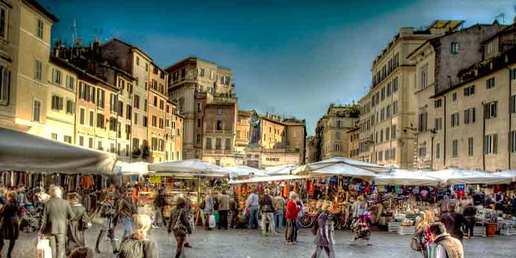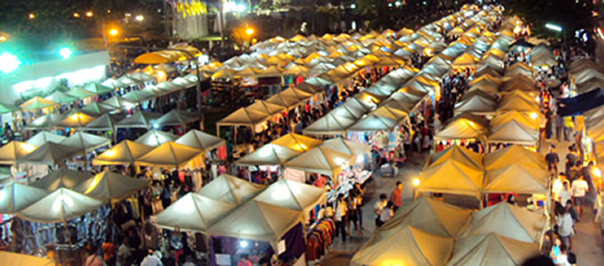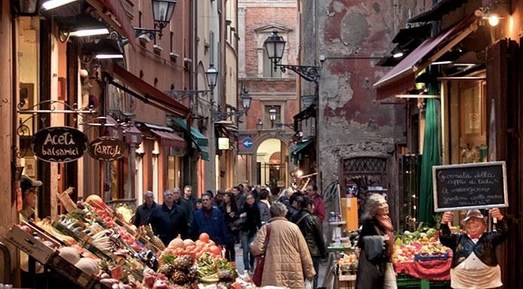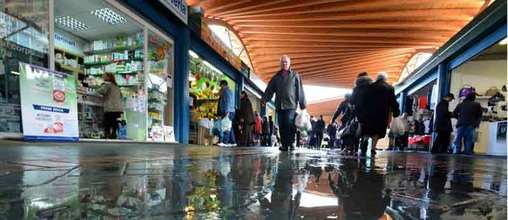|
The first time anyone travels to Italy, there are always a list of "must sees" that they try to squeeze into the limited time of their voyage. Especially when you're traveling as a family, you try to satisfy everyone's goals and dreams. But there are some things that might be missed due the to tight time constraints of checking in, checking out, train schedules, car rental pickups and drop offs, ad infinitum. So I came up with an idea for a second trip to Italy where one doesn't have to do any "must sees" and try to experience even more of day to day life in Italy. This idea is based on something we totally missed out on during our intensive three weeks Voyaging through Italy--markets. Markets in Italian towns are on very specific days and times. Usually they start early in the morning (especially true for food markets) and often close early. Flea Markets might only be held once a week or month. Authentic antiques markets might be held even less than that--perhaps once a month or season. We missed market days either because we were in the wrong place, or in the right town on the wrong day. We missed early morning markets because of tight schedules for check out and check in times, and time spent driving from one location to the next. The next time around, we're determined to slow it down a lot, pick fewer "hub" places to stay so we can live the Italian life at a slower pace--while experiencing the wonderful markets. Here's the plan... Forget tourist hot spots and "must sees" and shop where the locals shop for food (planning lots of picnics and cooking back at your apartment's kitchen). Plan your agenda on where you will buy food, fish, clothes or antiques. Book an apartment in a central hub location so that you can journey out to this town and that on market days.... hunting for the best cheese, fruit, sausages, leather bags, hand crafted fabrics, lace and more. Find a genuine antique to bring back home. So, decide on what markets you'd like to experience, book a flight and an apartment and gas up that rental car... Here are some options of various types of markets all over Italy... Enjoy your shopping! Naviglio Grande Canal Antiquties Market, Milano In Milan, you can enjoy a fantastic antiques market right on the banks of the Naviglio Grande Canal. Stalls offer furniture, porcelain, books, jewelry, paintings and prints and spans nearly a mile from Viale Gorizia to the bridge on Via Valenza. The market is open on the last Sunday of each month with many bars, shops, restaurants and numerous art galleries in addition to the vendors. Piazza dei Ciompi Flea Market, Florence Open daily from 9am to 7pm this is considered Florence's best flea market. It really gets busy on the last Sunday of the month its 100 extra stalls also overflow into the streets around. There's the usual eclectic mix that makes flea market shopping so addictive! Campo dei Fiori Market, Rome Campo dei Fiori translates as Field of Flowers, and in fact, there is a large contingent of vendors that sell wonderful flowers here. But primarily, this is a food market. It's a stunning piazza in the heart of Rome not far from the Pantheon with a gruesome past--public executions were held here. Though filled with tourists in the high season, the market is also frequented by locals. By night, it transforms into a great place to have dinner in one of its many outdoor ristoranti. And if you're staying in Rome, you can walk to this and many other types of markets... and not have to pay for gas.  Mercato Nuovo, Florence The Mercata Nuovo was named the "New" market when it was built, around the middle of the 16th century in the heart of the city, just a few steps from the Ponte Vecchio. Initially, it was intended for the sale of silk and luxury goods and then for the famous straw hats, but today mainly leather goods and souvenirs are sold. In the corner niches, statues of famous Florentines were installed during the 18 century. The focal point of the loggia is the Fontana del Porcellino--fountain of the piglet. What you see is actually a copy of the original bronze wild boar by Pietro Tacca from the sixteenth century marble. The original marble of the Porcellino can be found at Palazzo Pitti. Popular tradition has it that rubbing the nose brings fortune, so over time, the piggy's nose has developed quite a polish. Visitors are encouraged to place a coin in the mouth of the boar after rubbing its nose, and superstition implies that the wish will be granted if the offering tumbles through the grate where the water flows. The slope of the grate is such that most coins do fall through, and are collected by the city. Lungo il Tevere festival, Rome Not exactly a market, per se, but in the summer, the Lungo il Tevere festival runs from mid-June through the end of August and features vendors, restaurants, music, and bars in festive tents lining the river walk on the Trastevere side of the river. It’s the place to be, often until the wee hours of the morning. Porta Portese, Rome In the work-a-day Trastevere neighborhood, this is probably the most famous flea market in Rome It stretches from Piazzale Portuense to Viale Trestevere and is held on Sundays from 6.30am to 2pm. Bargaining will get you anything from 10 to 30 % off, so give it a go. You'll find everything here, including a lot of junk, but keep your eyes peeled and you may come home with a treasure. Mercato Orientale, Genoa At the Mercato Orientale (Eastern Market) of Genoa you can find everything from tripe to baked goods and fresh pasta, plus textiles, fruits, vegetables, household goods and footwear. It is a true gathering place, crowded by the locals, where they purchase traditional products, local foods, and specialties from different cultures.A visit here is an authentic experience and not to be missed if you are into local color color, flavors and scents. Molfetta Fish Market, Molfetta (Bari) When you visit an old world palatial fish market building like the one just off the harbor in the port town of Molfetta, you realize that we Americans are very fussy in our fish preferences. While the average U.S. supermarket has perhaps 4-6 types of fish, some shrimp and clams, Italians enjoy a much wider variety of sea food. We like to buy our fish in little plastic trays, trimmed and cleaned for us by someone we might not ever see. This market is a lively place--and not just the shouting fish vendors--but the fish themselves... the marble display slabs are brimming with fish so fresh that most are still alive and flapping about, shrimp's tentacles feel about, sea urchin's spines move and octopus try to crawl away. If you can get past the magnificent smell of the place (our boy Lucas objected), this is an experience you won't want to miss. (Read A Blessing in Molfetta's Waters) La Vucciria Market, Palermo La Vucciria is a Palermo's colorful, exotic market . If you leave Piazza Marina with the sea behind you you'll reach Corso Vittorio Emanuele, just before Via Maqueda on the right you should see, hear and smell the market. The colors, flavors and voices of Palermo come together and vendors will try strongly to entice you to buy their offerings, from freshly caught fish to unusual vegetables and amazing spices. Food stalls sell an array of sandwiches--panelle, chickpea fritters, aubergines, octopus - you name it. There are places to sit and have a meal too... and as you sit overlooking the market you'll think you're in the middle of Shanghai or Casablanca instead of Sicily. Porta Palazzo, Turino This market is held every day in Piazza della Repubblica in Turin, very close to the Porte Palatine and the Duomo. If you want to fully enjoy the market of Porta Palazzo, Saturday is the day to go--the busiest day, but also because every Saturday just behind the market there is a flea market, where you could find old records, antiques, postcards, vintage clothing, glassware, ceramics and more. The main market is very mixed: fruit and vegetables, household goods, butchers, fish, cheese, sausage, shoes, clothing and spices. This market is huge (one of Europe's largest), but it's also one of the more multi-ethnic markets affording more exotic offerings in addition to the more traditional Italian produce. Piazza del Ferrarese, Bari (Puglia) Piazza del Ferrarese, named after a Ferrara merchant who lived here in the 17th century, provides an elegant entrance to the old town. On your left are the rounded arches of Sala Murat which holds contemporary art exhibitions, and on your right is the old indoor fish market. The piazza is lined with bars and cafés, an old section of roman road roped off in the middle. On certain days there are food vendors under tents. To the north it merges into Piazza Mercantile. But for the authentic experience, walk a block or so south along the waterfront and you'll come across the waterside fish market where the daily catch is sold directly from the fishermen. You'll see a covered structure with concrete tables where the fishermen are supposed to sell their wares, but being furbo, most avoid the fees the city charges for this and sell their catch along the sidewalk just outside the structure. Piazza Campo del Palio, Asti This is Piedmont's largest food market held in the Piazza Campo del Palio in Asti. The Campo is also where horse races are held in September. This market is considered a general market with varied products being sold. It is open twice weekly on Wednesdays & Saturdays... clothing, shoes, haberdashery, hardware’s, household items, cheese, meat and bakery stands--and of course, the famous sparking Asti Spumonte wine. Fruit and vegetables in the morning only. You might think about planning a trip in September and take in the Palio race too! Ballarò Market, Palermo This is the market where you will find a lot of locals doing their shopping. A Sicilian street market is a cacophony of sights, sounds and scents. Be prepared for the shouting, barking and singing of the vendors pushing their products on you--fruits, vegetables, fish and meats--which can intimidate the uninitiated. The name probably comes from Balhara village, where there were Arab merchants. There is a strong Arabian influence in Sicily. The ambience is heightened by colored tarpaulins suspended as tents to protect the wares from the elements. Ballarò market extends from Piazza Ballarò in the Albergheria district toward the main train station. Forte Dei Marmi Antique Market, Lucca (Region) Every second Saturday and Sunday of the month, more than 45 traders from all over Italy travel to Piazza Dante, Forte Dei Marmi to be a part of the monthly antique market. The best of Italy’s antique collectors are the ones who take part in the market. Sculptures, art, collectibles, jewelry, furniture, books and artifacts are some of the items that are available on sale at bargain prices in this market. If antiques are your thing, this is a must visit place for you. In the end, you'll love Lucca as a place to visit. It became one of our favorite towns in all of Italy, and our most favorite in the North. Forte Dei Marmi Flea Market, Lucca (Region) Aside from being a busy beach town in the Lucca province, Forte Dei Marmi is a shopper’s paradise. The Forte Dei Marmi flea market opens every Wednesday from 8.00 to 14.30 at Piazza Macroni near the city center. Traders from all over Italy come over to display their wares. Everything under the sun, from crockery to branded designer wear, is available at this flea market for bargain prices. During summers when the tourist inflow increases, this market is open even on Sunday’s. This is the perfect place to shop, as you get the best of Italy. Mercato di Mezzo, Bologna The Quadrilatero area of Bologna has a long history of trade guilds since the Middle Ages. The main craft guilds of the city such as goldsmiths, butchers, fishermen, furriers, barbers and the painters, and Salaroli (specialists who salt cure meat) had their headquarters in this area. Most of the guilds located in the street once called Mercato di Mezzo, today known as via Rizzoli, at the beginning of the 20th century also moved in the heart of the Quadrilatero. Nowadays the Quadrilatero is the historical center area bounded by Piazza Maggiore, via Rizzoli, Piazza della Mercanzia, via Castiglione, via Farini, Piazza Galvani and Via dell’Archiginnasio. Jewelers, butchers, delicatessens, greengrocer’s, bakeries, shops with traditional cuisine and craft activities and other specialized trades are located in these streets. Most of these shops have preserved the historic architecture and furnishings, thus making themselves genuine artistic treasures. From the elegant Piazza Maggiore, the roads lead to the narrow alleys of the old medieval market overflowing with goods on the stands and full of noisy sellers and customers going by. Porta Nolana Fish Market, Naples Just a few blocks north of the port in the area around Piazza Nolana, under two towers of the old Aragonese gateway that stood guard over the ancient port entrance to the city, you’ll find Naples' best seafood market. And if you don’t mind crowds, chaos and confusion, this market is not to be missed. The vendors shout and sing about their offerings. Rarely frequented by tourists, Porta Nolana Market is where locals go in search of ingredients for their daily meals--clams, mussels, oysters, shrimp, squid, octopus, sea bass, sword fish, anchovies and sardines. And if you travel here for the Christmas season, you'll find the place inundated with locals buying fish for their Christmas Eve "seven fishes" feast--bacala (salted cod) and eel, for example. All this is the freshest seafood you'll find anywhere. Seafood isn’t all that's here... fresh fruits and vegetables, meats and cheeses, breads and desserts, and grocery items round out the market’s offerings. Cortonantiquaria, Cortona This top quality antiques fair is held annually, in late August and early September, in 17th century Palazzo Vagnotti, Cortona (a mecca for tourists ever since Under the Tuscan Sun hit the shelves), and has been going since 1963, making it Italy's oldest antiques show. Cortonantiquaria is now considered one of the most prestigious fairs in Europe and many dealers visit it, resulting in correspondingly high prices to go with the great number of tourists that flock to this oversold, but beautiful hilltown. The event is usually held between the last week in August through the first week in September. It's best to check for the specific schedule online. Mercato Centrale, Florence The Mercato Centrale was an authentic, big city, down and dirty food market before... but after a multimillion dollar renovation, it rivals the overpriced Eatalys around the world. Nowadays it's more of a tourist attraction, where locals go very early in the morning to get their food, and the tourists take over in late morning. They sell amazing things here... cheese, breads, meats, fish, etc.... but the fit and finish of the place caused the priced to go sky high. On the upper floor of this grand old market building, they created a modern, chic, industrial space that holds essentially a modern, chic, "foody" court full of bars, restaurants, pubs and the like. The outside of the market is surrounded by tacking clothing and tourist kitchy stalls. The prices are high, but it might be worth it for the urban foody to look into. Mercatino dell'Antiquariato, Venice You'll need to check your dates for this one, as you only get four chances a year, in April, June, mid September and Christmas. The three-day market is home to over 100 stalls with professional vendors selling everything from postcards to pearls and is held in Campo San Maurizio. It's renowned for having genuine antiques and not junk. Large, well organized and rich with treasures, professional dealers from all over Italy come to this market to sell their precious wares. Cheaper than antique shops, it's the place to find genuine antiques, statuary, books, paintings, glassware, ceramics and furnishings. This is the place to shop for an authentic piece of Italian history to bring back home and treasure. Mercatino dell'Antiquariato simply means Antiques Fair, be sure to go to the one in Campo San Maurizio which is the authentic market. Fiera Antiquaria, Arezzo Probably the biggest and most famous antiques market in the country is held in Arezzo, Tuscany, on the first weekend of the month. There are usually over 500 stalls spread over the Piazza Grande and the surrounding streets, which are manned (and visited) by people from all over Italy. You can buy everything there, from a pair of palazzo doors to a lace handkerchief. Some things are overpriced and it does get very crowded, especially during the summer, with an estimated average 20,000 visitors, but you may find a bargain and it will certainly be an experience. Arezzo is easy to reach: it is an hour by train from Florence and a couple of hours from Rome. The market is ten minutes from Arezzo Train Station and the square is surrounded by antique shops. If you love antiques, this might be your perfect destination. Mercato Coperto Santa Scolastica, Bari This is a recently built market on Viale Geiovanni XXIII that contains a mix of fruits, vegetables, fish, cheeses, breads, clothes, shoes and more. Although a lot of vendors complain about the additional costs incurred when compared to their old market space in another part of the city, there seems to be a growing following for this modern facility. It's in a neighborhood just south of the Bari Centrale rail station, but it is fully under cover and would be a great place to shop on a rainy morning. Eataly, Bari Not exactly a traditional Italian Market, Eataly is becoming a worldwide chain of mega Italian food spaces... part market, part food courts... all Italian. There are only two Eataly locations in the States--Chicago and New York. There is another in Istanbul, one in Dubai and also in Japan. But fittingly, I suppose, there are seven Eataly locations in Italy... and Bari has one of the largest right at the waterfront in the old convention center. The space is huge--86,000 square feet! We ate in the Eataly in Manhattan and found it over-marketed... way overpriced, very crowded and hard to locate specific items. There were very long waiting times if you wanted to sit in one of the various places to eat. Still, if you feel like checking our how Eataly looks in Italy, check out the one in Bari just across the harbor from the old city on Lungomare Starita just past the lighthouse... or check out the other Eatalys in Torino, Milano, Roma, Firenze, Genova and Bologna. I hoped you enjoyed this little tour of the markets of Italy... there are a multitude of possibilities. Most small towns have markets--but only on specific days. All larger towns have many types of markets... some for fish, some for clothes, some for fruits and veggies and others for books, leather, birds or flowers. Here's a LINK for a tool to help you plan your marketing voyage. Plan your trip around a tour of markets, or in the least, when staying in a central hub location, make a list of the markets in the region within driving distance. You'll be living the Italiana Buona Vita for sure... Ciao e buon viaggio! If you like this post,please tell your friends, share it and leave a link on your favorite travel site. Grazie! --Jerry Finzi You can also follow Grand Voyage Italy on: Google+ StumbleUpon Tumblr Copyright 2016, Jerry Finzi/Grand Voyage Italy, All rights reserved
1 Comment
7/31/2019 05:51:30 am
Great collection of markets. A few more to see next time. Thanks for sharing.
Reply
Your comment will be posted after it is approved.
Leave a Reply. |
Categories
All
Archive
June 2024
|


























 RSS Feed
RSS Feed
